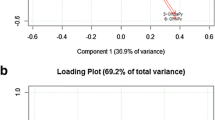Summary
The urinary excretion of hippuric acid and o-cresol was studied after respiratory exposure of human volunteers to approximately 80 ppm (306 mg/m3 ± SD 13) of toluene for 2 h under different work loads (0, 50,100, 150 W, respectively, during 30-min periods). The diet before and after exposure varied. An isotachophoresis method for the determination of hippuric acid is described. The correlation between the total urinary excretion, excretion rate and concentration of hippuric acid, and the respiratory uptake of toluene was poor or non-existing. The same was true for the excretion of o-cresol, which 4 h after exposure was concluded amounted to 0.03–0.26% of the toluene uptake. Thus, after a short-time exposure neither metabolite proved to be a reliable measure of individual toluene uptake at varying workloads or food intake in combination with low exposure levels.
Similar content being viewed by others
References
Angerer J (1979) Occupational chronic exposure to organic solvents. VII. Metabolism of toluene in man. Int Arch Occup Environ Health 43:63–67
Apostoli P, Brugnone F, Perbellini L, Cocheo V, Bellomo ML, Silvestri R (1982) Biomonitoring of occupational toluene exposure. Int Arch Occup Environ Health 50:153–168
Astier A, Deutsch AM (1980) High-performance liquid chromatographic determination of hippuric acid in human urine. J Chromatogr 182:88–93
Åstrand I, Ehrner-Samuel H, Kilbom Å, Övrum P (1972) Toluene exposure. I. Concentration in alveolar air and blood at rest and during exercise. Work Environ Health 9 119–130
Åstrand I (1983) Effect of physical exercise on uptake, distribution and elimination of vapors in man. In: Figerova-Bergerova V (ed) Modeling of inhalation exposure to vapors: uptake, distribution, and elimination, vol II. CRC Press Inc, Boca Raton, USA, pp 107–130
Åstrand P-O, Rohdal K (1977) Textbook of work physiology, 2nd edn. McGraw-Hill Book Co, New York
Bülow J, Madsen J (1978) Human adipose tissue blood flow during prolonged exercise II. Pflügers Arch 376:41–45
Carlsson A (1982) Uptake, distribution and elimination of methylene chloride and toluene. Arbete och Hälsa 3:1–41
Carlsson A (1982) Exposure to toluene. Uptake, distribution and elimination in man. Scand J Work Environ Health 8:43–55
Fišerova-Bergerova V, Vlach J, Cassady JC (1980) Predictable “individual differences” in uptake and excretion of gases and lipid soluble vapours simulation study. Br J Ind Med 37:42–49
Jolley RL, Scott CD (1970) Preliminary results from high-resolution analyses of ultraviolet-absorbing and carbohydrate constituents in several pathologic body fluids. Clin Chem 16:687–696
Ogata M, Tomokuni K, Takatsuka Y (1970) Urinary excretion of hippuric acid and m- or p-methylhippuric acid in the urine of persons exposed to vapours of toluene and m- or p-xylene as a test of exposure. Br J Ind Med 27: 43–50
Pfäffli P, Savolainen H, Kalliomäki P-L, Kalliokoski P (1979) Urinary o-cresol in toluene exposure. Scand J Work Environ Health 5:286–289
Sato A, Nakajima T (1979) Partition coefficients of some aromatic hydrocarbons and ketones in water, blood and oil. Br J Ind Med 36:231–234
Scott CD, Attrill JE, Anderson NG (1967) Automatic, high-resolution analysis of urine from its ultraviolet-absorbing constituents. Proc Soc Exp Biol Med 125:181
Sollenberg J, Baldesten A (1977) Isotachophoretic analysis of mandelic acid, phenylglyoxylic acid, hippuric acid and methylhippuric acid in urine after occupational exposure to styrene, toluene and/or xylene. J Chromatogr 132:469–476
van Sumere CF, Teuchy H, Pe H, Verbeke R, Bekaert J (1969) Quantitative investigation on hippuric acid formation in healthy and diseased individuals. Clin Chim Acta 26:85–88
Szadkowski D, Borkamp A, Lehnert G (1980) Hippursäureausscheidung in Harn in Abhängigkeit von Tagesrhythmik und alimentären Einflüssen. Int Arch Occup Environ Health 45:141–152
Veulemans H, Masschelein R (1979) Experimental human exposure to toluene. III. Urinary hippuric acid excretion as a measure of individual solvent uptake. Int Arch Occup Environ Health 43:53–62
Wilczok T, Bieniek G (1978) Urinary hippuric acid concentration after occupational exposure to toluene. Br J Ind Med 35:330–334
Woiwode W, Drysch K (1981) Experimental exposure to toluene: further consideration of cresol formation in man. Br J Ind Med 38:194–197
Author information
Authors and Affiliations
Rights and permissions
About this article
Cite this article
Andersson, R., Carlsson, A., Nordgvist, M.B. et al. Urinary excretion of hippuric acid and o-cresol after laboratory exposure of humans to toluene. Int. Arch Occup Environ Heath 53, 101–108 (1983). https://doi.org/10.1007/BF00378422
Received:
Accepted:
Issue Date:
DOI: https://doi.org/10.1007/BF00378422




